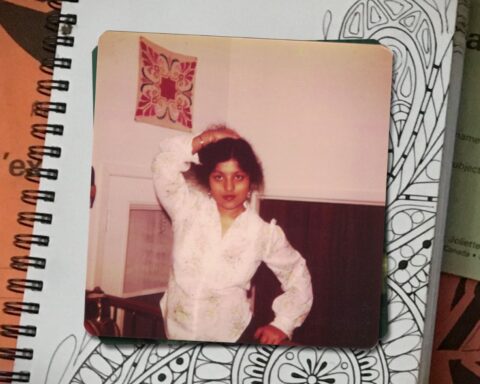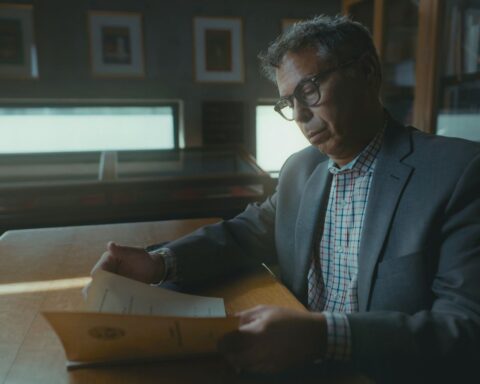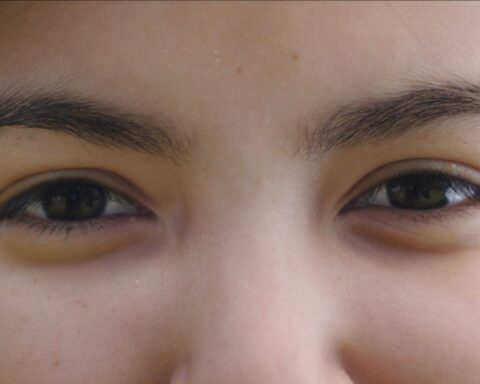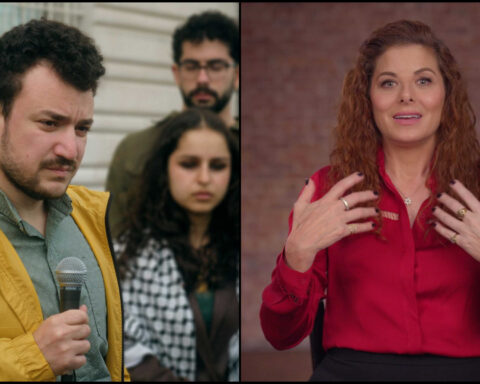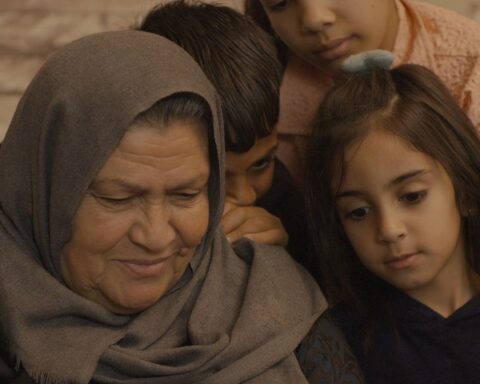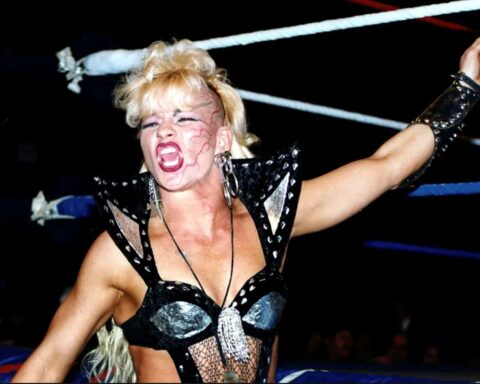Veteran director Jennifer Baichwal and her partner, cinematographer and producer Nick de Pencier, have collaborated with internationally acclaimed photographer Edward Burtynsky on what will surely be one of the top documentaries of the year. Watermark, co-directed by Baichwal and Burtynsky, is a cinematic essay—an “immersive experience,” according to Baichwal.
The film explores the many properties of water. Positively, this new documentary shows water as a cleansing source, a place of astonishing power, a spiritual force, and as the essence of the human body. By contrast, Watermark harshly reminds us of the pollution that is destroying water, how huge dams are harnessing its power while also destroying natural resources and communities—and perhaps most devastatingly, how water is a harbinger of what can happen to a worldwide industrial system that is creating climate change. Watermark takes viewers on a cinematic journey through 10 countries, offering many stories, among them: how water affects scientists in the Arctic, rice paddy workers, California surfers, Indigenous people in northern B.C., and a mass of spiritual seekers in southern Asia. It’s a vast exploration and, in some ways, a continuation of Manufactured Landscapes, Baichwal and de Pencier’s award-winning profile of Burtynsky. Watermark extends that film: Burtynsky is now a co-director and co-producer, as well as a cinematic subject. The three have worked together, meshing their talents to create a gorgeous and thoughtful look at water itself.
The film is part of Burtynsky’s “water project,” which also includes a major new book, parts of which we glimpse in the film. Burtynsky-Water, a publication by the noted art press Steidl, will also be available this fall. It’s a continuation of Burtynsky’s work, which is recognizable for his signature big-picture approach, both in terms of the large scale of his stunning photographs and the consequences of their environmental content.
Burtynsky’s previous projects have included investigations of mine tailings, quarries, ship breaking in Bangladesh, manufacturing in China and a global investigation of oil in all of its manifestations. His acclaimed publications include Manufactured Landscapes (2003), winner of the Roloff Beny Book Award; Burtynsky: China (2005); Edward Burtynsky: Quarries (2007); and Burtynsky: Oil (2009) among others. Over the last five years Burtynsky has photographed water from a global perspective that considers various topics including: distress, control, agriculture, aquaculture, waterfront and source.
Burtynsky was one of the inaugural winners of the TED prize, which has also been rewarded to such luminaries as Dave Eggers, Karen Armstrong, Bono and Edward O. Wilson. He is an Officer of the Order of Canada.
Jennifer Baichwal and Nick de Pencier have created award-winning documentaries since they started collaborating on the profile of novelist and composer Paul Bowles, Let It Come Down (1988). Since that acclaimed debut, they’ve made films on the photographers Shelby Lee Adams (The True Meaning of Pictures, 2004) and Edward Burtynsky (Manufactured Landscapes, 2006); the nature of debt—with the input of writer Margaret Atwood (Payback, 2012); and the role of coincidence in life (Act of God, 2008). They’ve won Genies and Geminis, a cultural prize at Hot Docs, an eco-hero award at Toronto’s Planet in Focus festival and the TIFF award for best Canadian film.
MG: Marc Glassman, for POV
JB: Jennifer Baichwal | NP: Nick de Pencier
MG: On Watermark, Jennifer, your collaborators are Edward Burtynsky and Nick de Pencier, both excellent with cameras. How did the cinematography work? Who shot what?
JB: Nick was the supervising cinematographer and shot almost everything, with a few exceptions. Since Manufactured Landscapes, and even before, Ed has been interested in the filmmaking process. We always talked about Watermark as a three-way collaboration. We didn’t formalize anything; we just all settled into the roles that are our strengths, and they complemented each other.
Ed’s strength is the big picture. He’s very good at finding the vantage that gives you the right sense of scale. This is very difficult to achieve. I felt our job was more to tease out all the narrative details—the personal stories, the intimate moments—that gave those wide views meaning.
MG: I recognized some of the locations from photographs that Edward had taken. Were the locations chosen in a collaborative way?
JB: Some Ed was already researching and knew about, and some not. For example, we wanted to explore what a pristine watershed looks like. Ed has a place near the Beaver River, so we went up there and looked around. But it wasn’t quite majestic enough for a thread for our film. I said, “If we’re going to film a watershed, let’s go to the mother of all watersheds. Let’s go to northern B.C.!” So we ended up in the Stikine River watershed, which is 52,000 square kilometres. Wade Davis hosted us at his camp and introduced us to the Tahltan linguist Oscar Dennis, who described the area, where he grew up, as ‘the top of the world.’ That’s how we found our location.
MG: Did you have a structure in mind when you started working on the film?
NP: We all acknowledged from the beginning that the subject matter, to make a film about water, was so open and vague as to be arbitrary, and so necessarily had to become subjective. In the seminal conversations that Ed and Jennifer and I had, we knew that if it was going to work, the film would have to have lots of contrasts between the different representations of water. You would get a visceral sense of water through contrasts: hot and cold; very dry locations and very wet ones; tightly shot scenes and large vistas. Ed, in the arc of doing his new book Burtynsky: Water, realized very early on that aerial perspective is really the way to get an understanding, because…
JB: Of scale.
NP: Yeah, of scale—whether you’re looking at a watershed or viewing a dam in China. Many of his pictures are like that now. But if you spend too much time floating up there, it becomes two-dimensional.
Getting back to roles, it took me a day just to wrap my brain around the dam. It’s such a huge project, and to get from one side to the other—you could spend the day just travelling around it and not even filming. A lot of times we would divide up. Ed would be looking at that more comprehensive view and vantage point, and often would be directing the remote control helicopter, let’s say, which we shared between his Hasselblad for stills and our video cameras. At the same time, Jennifer and I would go and find the more human narratives, the interviews, the moments of being, on a smaller level.
JB: We never work with a strict script, as you know; I don’t believe in that. It works for some people, but it’s not our process. We always have an outline and a vision and a philosophical idea of what we’re trying to do, and then we go into the field.
We were in 10 countries; there are 20 different stories in the film, so it’s really a mind-boggling number of threads to juggle. That’s why it’s so ‘messy’—a 180:1 shooting ratio—and why it took so long to edit. But that’s how the story emerges.
We always write an outline for funders and then sort of forget about it. At the end of the edit, I look at it again and realize how close we are to that outline, even though it was intentionally quite broad.
The film is meant to be an immersive experience. The main idea is putting you, the viewer, in a space where you’re just washed over by water in all of these different incarnations. At the end of it, you should have a different understanding of water, not just as resource, but as a powerful force that runs through life in every way.
MG: Did you ever feel that you should make the film about environmental issues—for example, climate change?
JB: That’s only one part of the story. The section in Dhaka, Bangladesh, which deals with industrial water, could have been taken to that level. We interviewed a wonderful guy, Sharif Jamil, who is the Buriganga Riverkeeper. His job is to try to regulate and protect the river, and it’s a massive uphill battle. But even his story became too didactic. It shifted from an experiential process to hard information. I really dislike films that tell you what to think, and so many documentaries do. They advance a thesis, then spend the whole film backing up that thesis, and I just find that such a limiting and reductive way of thinking about the world.
NP: Plus working with Ed, I think some of the same oscillations in the editing room where the structure was being written echoed the process in Manufactured Landscapes, which initially had lots of expository information, but we realized that took away from what the film is an interesting artist in that he doesn’t choose subjects that don’t resonate with layers of meaning and information underneath. If you look at Burtynsky: Water, you see these incredible pictures and at the back of the book, it is all explained. There are some interesting notes that let you contextualize why this is an interesting subject to be part of this essay, but that information is not right there on the page.
I think that’s exactly what this film wanted to be, too. It’s basically an art film, but it’s not purely abstract, not purely experiential. It takes as its subject things that have layers of meaning underneath that you don’t need to make explicit to resonate, but that’s the intention.
JB: But what do you mean by “art” film, Nick?
NP: (Pauses) The term “documentary” includes such a wide range of ways of approaching form. But always there is one foot in the purely aesthetic, and the other foot is in a more kind of journalistic terrain. That’s a wonderful marriage, right? This film is leaning a lot of weight on the aesthetic foot.
JB: But it isn’t only aesthetic. In the beginning, when we were trying to figure things out, we were saying to Ed, “You know, you have to be rooted in the Earth. You can’t just fly in the sky.” I would say that the moments we have—with the mysterious rice paddy figure or the women who are working in the tannery or the people at the Kumbh Mela who are having these intensely private religion experiences surrounded by millions of people—I wouldn’t call those aesthetic. I would call them human. Experiential. They say to the viewer, “Here, come on this journey all around the world to all these different places related to water that you normally wouldn’t go to or see and be part of that, be immersed in that.”
MG: What video cameras did you use?
NP: Our main camera was the Epic from RED, which has a 5K sensor. We got a prototype that was hand assembled. We decided that that was the way that we could on the cinema side have a congruent path to Ed’s detail resolution that he gets from his incredible cameras. The Epic is a terrible documentary camera because it’s just this little box, and so if you’re Peter Jackson on The Hobbit and you have a five person camera department, each who can do their own little bit, that’s great, but for me, often going solo, it was challenging, especially for the verité and even the interviews. Quickly it got supported by a whole cast of similar cameras with the not-as-good quality on the visual side, and it became the money-shot camera, basically. We used it whenever we could.
MG: Nick, your work here calls into question central notions of photography and cinematography. You use zoom-ins and zoom-outs, either to or from establishing shots that look like knockout photographs. Only they’re not photographs, they’re in a film.
NP: And they’re moving. We worked very hard for those. There were big, big challenges. We threw everything we had at them and it was a great pleasure. I think it’s a high watermark for those people and for us.
JB: Technically, using the remote camera was a challenge. We took the remote helicopter guys to China with us. We had an Epic camera on a remote-control helicopter flying over the dam. We climbed down onto the dam construction site at night, and I don’t want to know how many people died in the making of that dam. I would not say that safety concerns are paramount. It was scary but fascinating, and definitely worth it.
MG: When you switched to other cameras, what did you use? Were they variations on the RED?
NP: Pretty much they were all large sensor cameras—the world is switching to look at that more cinematic frame size and all the attendant things, like a very shallow depth of field.
MG: Did you have a set-up like Ed has with his Hasselblad? Were you actually looking at a computer while shooting?
NP: No, I’m always shooting. I don’t have a computer-tether. The only exception is when I’m in the helicopter, I have a monitor because the camera is outside or on a wall. It’s sending the proxy feed back down so we can frame and see where it’s going. I’m able to see that. But, no, whenever I’m with the camera, I’m shooting. But it was hard, you know? When we got to the rice paddies, there was 10 inches of berm to walk along, and water on both sides.
JB: I don’t think you ever fell in.
NP: I fell in a few times, but I always had an out for my camera. I could always put my camera on a ledge if I was going in.
MG: There must have been discussions between the three of you about visual strategy.
JB: We talked about that all the time. Those high vantages are not always easy to get; the dam was especially difficult. We attached the Epic to a cement bucket so it would go across the dam, and we would get that vantage. Nick was really worried that it was going to fall, not just because it would get wrecked, but because it would kill somebody. We were taking cameras where they would not normally go—in the sky—to get a different view.
NP: Ed was taking stills for the book and then other times he was directing the remote-control helicopter, if I wasn’t doing it.
MG: In the rural Asian scenes, when a family is seen sitting, eating, telling anecdotes—how did that work?
JB: That was Nick and I, working alone with a translator.
I think you have to have a particular attitude. Ed has unbelievable patience for the right light. That’s the kind of thing that makes me impatient: we’re standing one place and waiting for one shot and the right light and I’m going crazy because I’m thinking about all the things I could be discovering or filming.
But I think from experience that we have the right patience for finding the feeling of a place, and not disrupting it too much. We had all these subjects lined up by researchers in the paddies and they were all not right somehow. But we kept just walking the fields and on the last day we saw this strange figure in a pink hat and both knew immediately that we had found our character. And now he’s an important part of the film.




